17th century to early 19th century
Park Lodge Stables are located in the very centre of the town of Newmarket, close to the Jockey Club Rooms and the National Horse Racing Museum. The Museum stands opposite what remains of the racing palace of Charles II, and is incorporated into the former Palace House Stables which were run down and derelict prior to being redeveloped into the magnificent, modern Racing Museum. However, the Newmarket story begins almost two decades before Charles II arrived in the town. On Wednesday 27th February 1605 James I visited Newmarket and realised that the wide-open expanses made it the perfect place to stage sporting events, although it was to be 17 years later before the earliest record of a match on Newmarket Heath took place on Friday 8th March 1622. Charles II, the Merry Monarch, was aged 35 when he founded the Newmarket Town Plate in 1665, going on to win it twice himself, firstly on 14th October 1671 and later in the spring of 1675. He appointed Robert Baynton as Keeper of the Running Horses in Newmarket, and continued to enjoy visiting the town, delighting in racing and other pleasures the town could offer, right up to his death on 6th February 1685 aged 54. King's Plates were staged regularly each August and October in the early 18th century, with special mention given to the years 1716 to 1718. With such strong Royal connections, the whereabouts of the site of the earliest Royal Stables was a challenge which the Channel 4 Time Team took on in the summer of 2013. Park Lodge Stables was justified in staking its claim.
For over 4 centuries racing has been staged in Newmarket, but how have the racecourses evolved from an initial starting point at Fleam Dyke Pumping Station, some 8 miles from the town, with a winning post barely 200 metres from the town centre, into two world recognized, excellent racecourses and a universal acceptance that Newmarket is the Headquarters of racing?
To access an interactive racecourse map showing over 50 individually named racecourses CLICK HERE. The map will enable you to:-
1. Determine when extended races over 8 miles, 6 miles and 4 miles began to be replaced by the courses now visited by thousands annually;
2. Consider how the challenge of crossing the Devil's Dyke was overcome;
3. Contemplate why the town no longer has a steeplechase course despite having at least 5 courses during the past 2 centuries;
4. Examine the practicalities of having up to 48 starting posts and winning posts;
5. Appreciate that it was not financially viable to have an open racecourse spread widely across the heath, with a finishing post barely 200 metres from the town centre;
6. Research how and why the Cambridgeshire Handicap has been contested over 3 different courses.
NOTE: The map does not make mention of 2 particular courses:-
(i) Sefton Course (also known as the Cambridge Road Course)
Source: 1970 Raceform.Used from 1959 to 1975.
(ii) New Circular Course
The Circular Handicap was run on Friday 29th October 1875 on the New Circular Course of about two miles.
Source: London Standard (30th October 1875): ''the horses started near the Turn of the Lands, ran back way of the Cambridgeshire Course towards the Ditch, and afterwards proceeded down the side of the Tan Gallop, and turned into the Rowley Mile near the Bretby Stakes starting post, finishing at the stand at the end of the flat. Except in the hollow near the Cambridgeshire start the runners should have been visible all the way if the sky had been bright and clear''.
Another report hoped that the Circular Handicap would become a feature in future programmes, as it would be contested in front of the new grandstand which would be completed in about a year and would be able to accommodate thousands.
(I am grateful to Tim Cox for bringing attention to these 2 courses.)
Enjoy researching the intriguing history of Newmarket and its many racecourses.
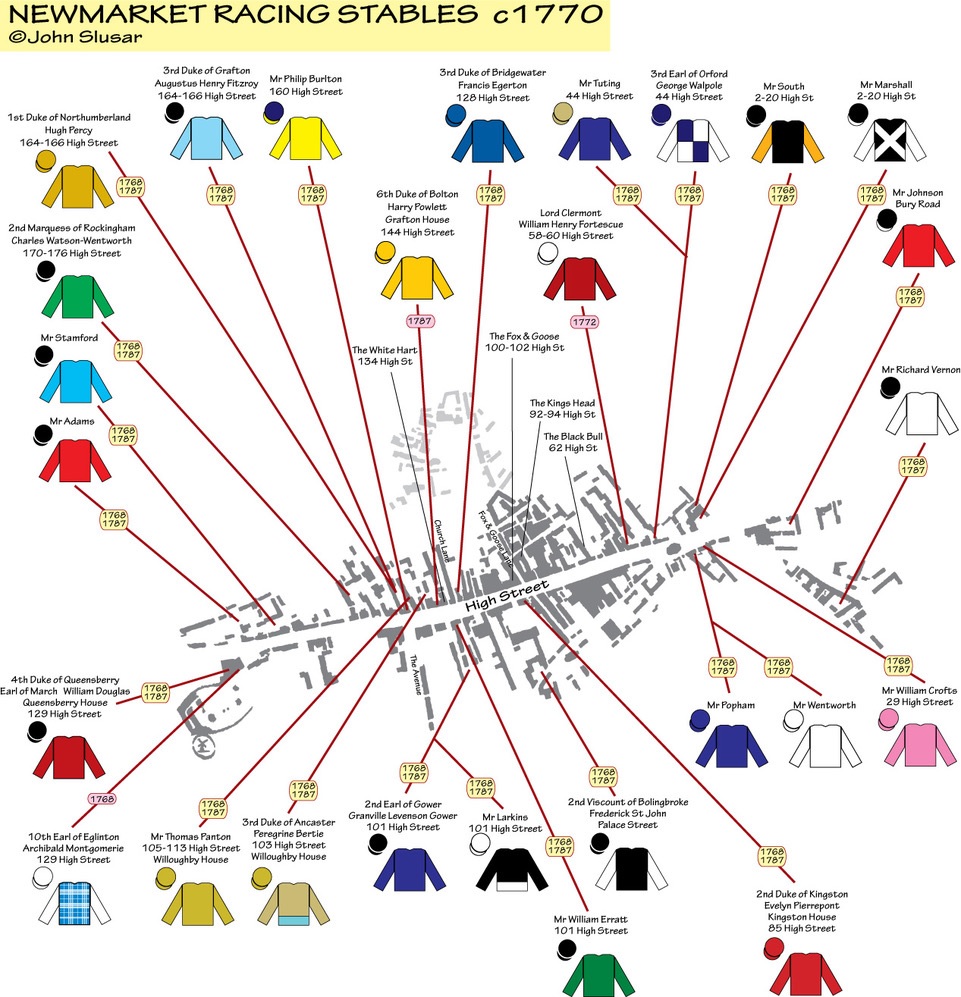
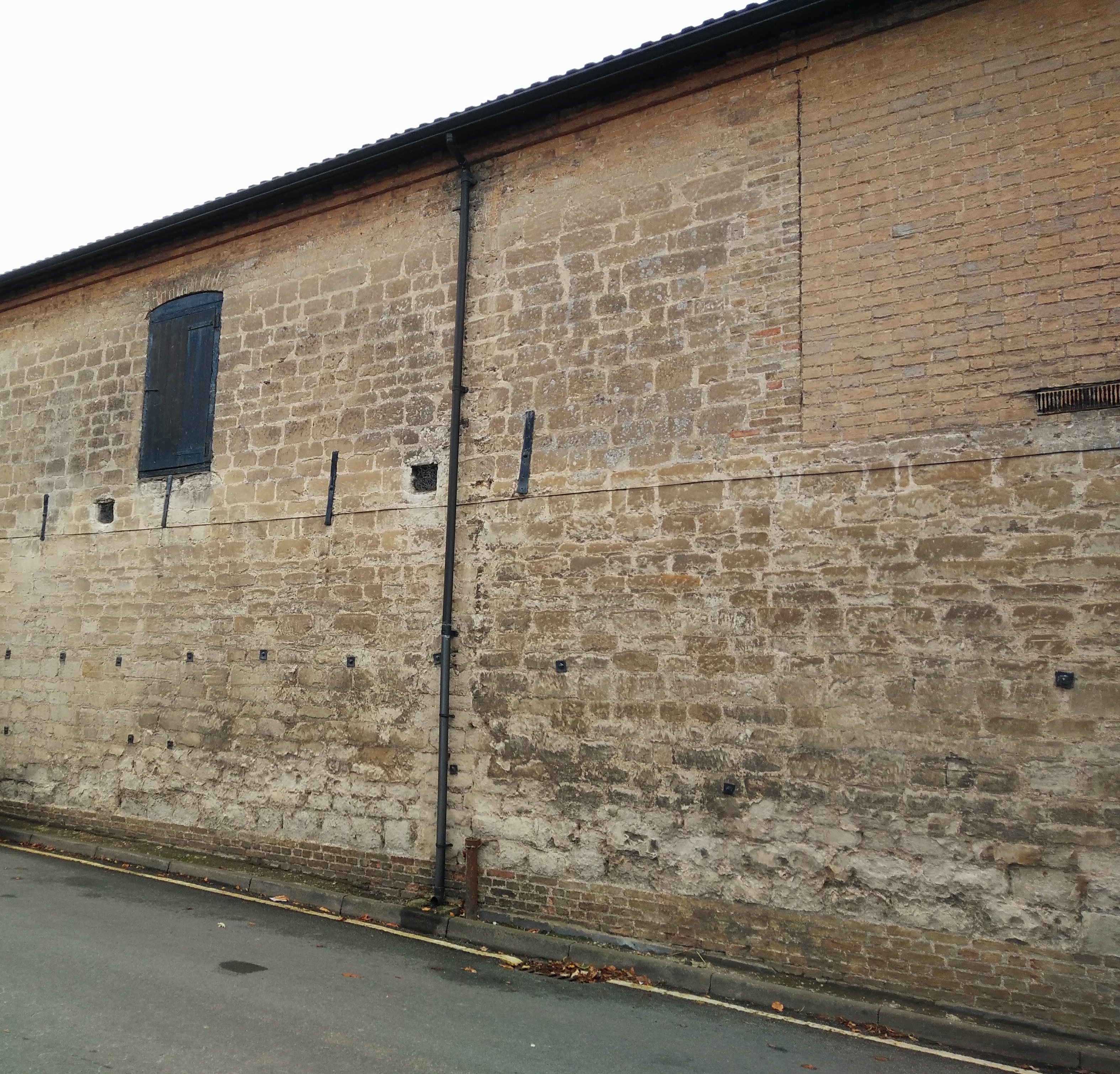
Early 19th century-1844 William Crockford
Park Lodge came to prominence as a racing stable in the town in the early part of the 19th century when purchased and developed by major landowner William Crockford. Historically the ancient trackway of Icknield Way was one of 4 highways, along with Fosse Way, Watling Street and Ermine Street, which were constructed by Royal Authority. Icknield Way linked the old hill-forts of Norfolk to Wiltshire, and is believed to have straddled the outer edge of Park Lodge Stables before it wound its way up Palace Street. William Crockford, born on 13th January 1776, was formerly a wealthy fishmonger and landowner, and purchased Park Lodge to indulge his habit of gambling on the horses, having also built Crockfords, the famous gaming club, in 1827 at 50-53 St James's Street, London. Although the exact date of Crockford's arrival in the town is unknown, there is every likelihood that he was present at the start of the 19th century. Crockford's Stud, on the Woodditton Road, still remains today, and was probably his base when in Newmarket, although he owned Park Lodge Stables and allowed his Head Groom, (the term for a trainer in those days) to live in Park Lodge House. Crockford died on 24th May 1844 at 11 Carlton House Terrace, which later became Lord Gladstone's house, but not before William Crockford had witnessed the completion of Park Lodge, although there is some evidence of building work on the site in the 17th and 18th century. The house was further developed in the 19th century, while the stables were extended in the early 20th century by Sir Jack Jarvis.
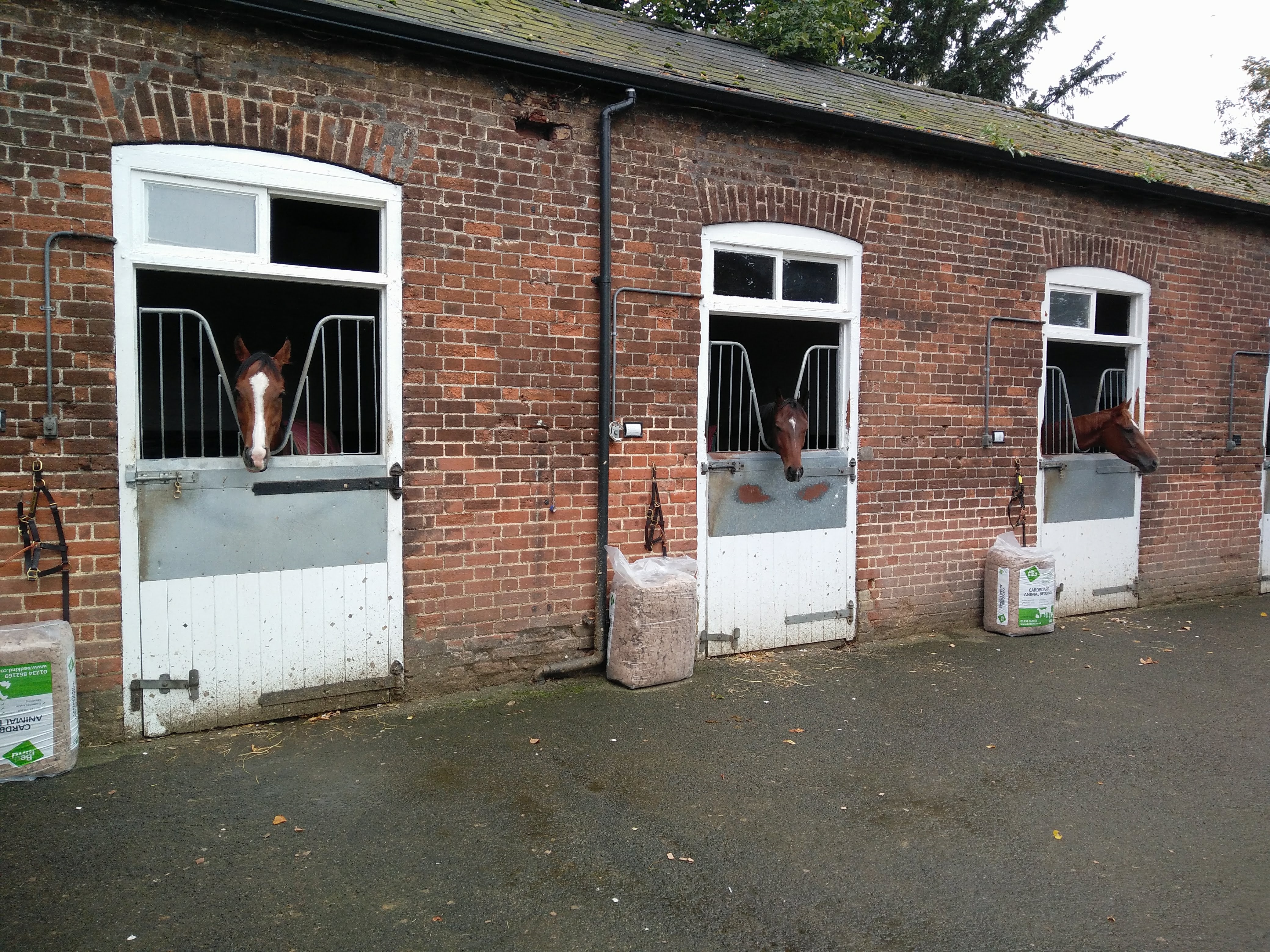
1870-1888 Charles Maidment, Henry Bradley
The 1873 Kelly's Directory records Charles Maidment as the jockey of the Park Lane Stables, while the 1888 Kelly's Directory lists Henry Bradley as the travelling Head Lad, James Goater and Gustavius Lowe as the jockeys, while Robert Peachey is listed as the Blacksmith. Charles Maidment was born on 4th April 1845 at Sixpenny Hadley in Dorset. He won the 1872 Epsom Derby on Cremorne (SR 2065), having already jointly captured the two Flat Jockeys Championships in 1870 (tied on 76 with W Gray) and a year later in 1871 (tied on 86 with George Fordham). He also won the 'Fillies' Triple Crown in 1871 with Hannah (SR 2014), the 1872 St Leger with Wenlock (SR 1881), and his second Epsom Derby in 1876 with Kisber (SR 2061). He remains the only jockey to have won the Lincoln Handicap four times, initially with Indigestion (100/6) for owner Sir C Legard and trainer C Bloss in 1868, following it with victory on Royal Rake (11/2) in 1870 for Lord Rendlesham and trainer C Blanton. His third success was in 1872 on Guy Dayrell (100/6) for Mr Chaplin and trainer C Bloss, while his final victory was in 1873 on Vestminster (12/1) for Mr A E Hope and trainer F Balchin. He continued to ride exercise on Newmarket Heath well into his later years, dying in Newmarket on Saturday 17th December 1926.
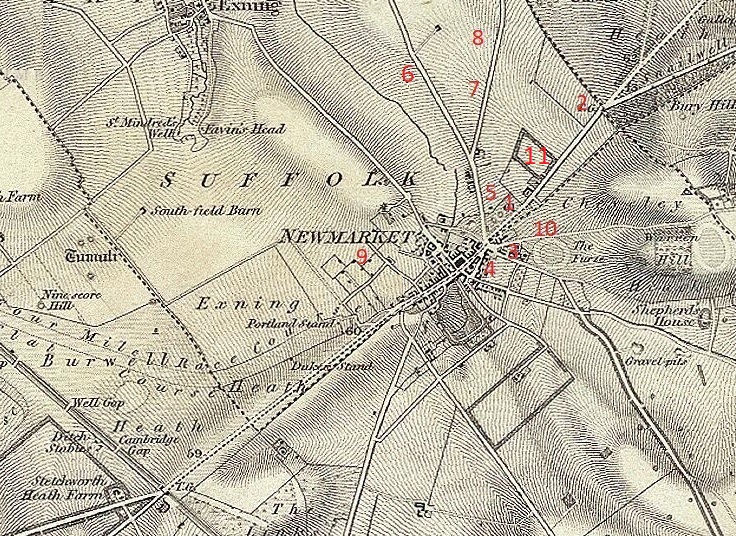
1883-Autumn 1886 Robert Peck, Martin Gurry, Edward Bambridge
As well as managing Beverley House, where he installed Jim Hopper as trainer, Bob Peck shared control of Park Lodge where he installed Martin Gurry to train horses Peck owned in partnership with General Owen Williams, including The Baird who won 16 consecutive races in 1885 and was runner-up to Ormonde in the 1886 Derby. The Peck/Gurry partnership ended at the close of the 1886 Flat season, Gurry going on to Bedford Lodge, training for Squire George Baird who leased Bedford Lodge from Captain James Machell. Also in the 1880s Jimmy Ryan was based at Park Lodge. In December 1884 Edward Bambridge leased 10 boxes at Park House stables, remaining for a couple of years before moving to The Nunnery where he remained for the rest of his training career.
THE BARD (SR 2040)
The Bard, a chestnut colt by Petrarch out of Magdalene, was foaled on 2nd May 1883, jointly owned by Robert Peck and General Owen Williams, and trained at Park Lodge by Martin Gurry, Head Lad of Robert Peck. His sire, Petrarch (SR 1935), won the 1875 Middle Park Stakes, following up in the 1876 2000 Guineas, 1876 St Leger and 1877 Ascot Gold Cup, while his dam, Magdalene, was also useful, winning the 1872 Newport Cup, and 1873 and 1874 Great Shropshire Handicap at Shrewsbury. The Bard won a remarkable 16 consecutive victories in an unbeaten two-year-old career, despite being born in the same year as the great Ormonde, although he was placed strategically to avoid Ormonde during his early career. He had chalked up 6 victories when he was still technically a yearling, for he did not turn 2 years old until 2nd May 1885. When The Bard finally met Ormonde in the 1886 Epsom Derby it was Ormonde (SR 2063), ridden by Fred Archer, who proved to be the better by a length and a half. In a career spanning 25 races, The Bard won 23, including the 1886 Goodwood Cup and Doncaster Cup, and went on to achieve great things at stud.
16 Consecutive victories in unbeaten two-year-old career
Tuesday 24th March 1885 Brocklesby Stakes (5f) at Lincoln, THE BARD (7/2 fav) beat Hygiene by 2 lengths 16 Ran
Thursday 26th March 1885 Molyneux Stakes (5f) at Liverpool, THE BARD (4/7 fav) beat Athlestan by 3 lengths 10 Ran
Tuesday 14th April 1885 Althorp Park Stakes (5f) at Northampton, THE BARD (6/5 fav) beat Counterfeit by 4 lengths 6 Ran
Wednesday 15th April 1885 Ascot Plate (5f), THE BARD (1/4 fav) beat Assignation by a neck 6 Ran
Tuesday 28th April 1885 Westminster Stakes (5f) at Epsom, THE BARD (1/20 fav) beat Cousigne by 1/2 length 2 Ran
Wednesday 29th April 1885 Hyde Park Plate (5f) at Epsom, THE BARD (1/4 fav) beat Balnagowan by 3/4 length 5 Ran
Thursday 30th April 1885 Sandown Park Two-Year-Old Stakes (5f), THE BARD (1/5 fav) beat Filly by Ethelred by 3/4 length 5 Ran
Tuesday 19th May 1885 Spring Two-Year-Old Stakes (5f) at Newmarket, THE BARD (18/100 fav) beat Calais by 1 length 4 Ran
Friday 22nd May 1885 St George’s Plate (5f) at Windsor, THE BARD (1/2 fav) beat Coquille by 1/2 length 5 Ran
Tuesday 26th May 1885 Hartington Plate (5f) at Manchester, THE BARD (1/10 fav) beat Colt by Muncaster by 1/2 length 3 Ran
Wednesday 27th May 1885 John O'Gaunt Plate (6f) at Manchester, THE BARD (1/5 fav) beat Breadknife by a neck 3 Ran
Thursday 18th June 1885 23rd New Biennial Stakes at Ascot 5f 136 yds), THE BARD (2/9 fav) beat Campbell by 6 lengths 4 Ran
Wednesday 15th July 1885 Mersey Stakes at Liverpool, THE BARD walked-over
Friday 17th July 1885 July Plate (6f) at Manchester, THE BARD (1/10 fav) beat Alaric by 3 lengths 3 Ran
Friday 24th July 1885 Great Kingston Stakes (5f) at Sandown, THE BARD (2/7 fav) beat by Cissy 3/4 length 5 Ran
Wednesday 16th September 1885 Tattersall's Sales Stakes (7f) at Doncaster, THE BARD (12/100 fav) beat Martial by 3/4 length 4 Ran
The plan opposite is shown courtesy of Messrs Feist & Son, and James Eustace, and represents the plans which were issued prior to sale by auction in October 1889. Note that there are a number of interesting features shown on the plans, but equally there are some features missing from the plans because they were added later.
Number 1 A carriage block is marked on; today it is a stable block much larger than adjacent stables;
Number 2 A complete stable block was built along the far section of the Stable Yard, probably at the time of Jack Jarvis, and it was in the box marked by a 2 that 1939 Epsom Derby winner Blue Peter (SR 2089) was stabled;
Number 3 The end stable in the block added by Jack Jarvis was occupied by 1944 Epsom Derby winner Ocean Swell (SR 2033);
Number 4 In a small outer stable block, not present on the 1889 plan, the yearling Sleeping Partner was stabled;
Number 5 When 1969 Epsom Oaks winner Sleeping Partner (SR 1877) began her racing career she was moved from an outside box to one in the oldest part of Park Lodge;
Number 6 When the 2013 Time Team investigated the possible location of the earliest Royal Stables they discovered an ancient wall in the outer perimeter of the gardens of Park Lodge;
Number 7 The oldest part of the stables made of Suffolk Clunch/Burwell Stone;
Note the additional information on the 1889 plans mention Mr Peachey and R C Naylor. In the 1888 Kelly's Directory Robert Peachey is recorded as the Park Lodge Blacksmith. While Mr Richard C Naylor was a fearless gambler and racehorse owner whose horses were trained by James (Jem) Godding, predominantly at Palace House Stables. Richard Naylor owned the 1862 Epsom Oaks winner Feu de Joie (SR 1949) which was ridden by Tom Chaloner, and the 1863 2000 Guineas and Epsom Derby winner Macaroni (SR 2017) also ridden by Tom Chaloner.

Edward Bambridge was born at Harlow in 1843 and began his working career as a bank clerk in Chelmsford. His father, Edward Colman Bambridge, had retired from the Excise Department to run the Green Man, a famous Harlow hunting inn. Bambridge senior was a considerable racing enthusiast, as were his other sons Jack and William. The latter was a very successful gemtleman rider under both codes during the 1860s and 1870s, mostly on metropolitan courses, though he had a Grand National mount, Loustic, in 1873. Edward Bambridge started training in a small way and had premises in Back Street, Royston, in the 1870s. He had 22 horses there in 1880 and in 1882 he moved to Cooksbridge near Lewes with 10 horses. In December 1884 he moved to Park House stables at Newmarket, recently occupied by Martin Gurry, leasing 10 boxes on a 2-year lease from Robert Peck. A couple of years later Bambridge bought the Nunnery Stables where he remained up to his death.
Autumn 1886- March 1889 William Gilbert jnr
William Gilbert, born at Stockbridge in 1861, was the second son of William Gilbert senior. Though his father died a prosperous man William inherited little more than the use of Savile House in August 1883 and started training with capital of £200 and some saddlery. He continued with Lord Cadogan's horses, initially privately, but was soon training for others too, including himself. He trained the winners of the 1883 Cork and Orrery Despair, the 1885 Ebor Handicap Mate, and 1886 Royal Hunt Cup Despair, Despair being in his own colours. Furthermore, Lord Cadogan's Lonely (SR 1966) won the 1885 Oaks with Fred Archer on board. In autumn 1886 Willam Gilbert jnr bought Park House stables from Robert Peck for £5,000, the money being borrowed from friends, and he moved there in February 1887. He soon had to mortgage the property for £4,700. By June 1888 he knew he was insolvent, but then received the horses of Mr R C Naylor. However in March 1889 Cadogan removed his horses to Mathew Dawson and Gilbert went bankrupt in Autumn 1889.
1891-October 1894 R Sherwood junior
By the early 1890s Robert Sherwood junior was training for Mr Foxhall Keene at Park Lodge, although once Robert's father died in October 1894 he took charge of St Gatien Stables.
Pierre Lorillard, who took Lower Hare Park for three years from October 1895, and at the same time took Park Lodge stables, was looking to retire from the Turf, but wanted to ensure that Huggins, who had trained for him, was not left in the lurch. In the event Huggins joined Lord William Beresford at Heath House stables.
September 1896-1897 George Chaloner
George Chaloner was born at Middleham on 9 November 1869, a son of Tom and Ellen Chaloner, and educated at South Hill School at Bury St Edmunds. His first ride was in October 1883 but his first winner was on Jacob at Hampton on 16 June 1886 by which time his apprenticeship was with his mother Ellen. By 1896 his weight had caught up with him and backed by Captain Machell who had been associated with many of his winners he set up as a trainer in the autumn, being granted a Newmarket licence in September. Initially he was to lease Park Lodge from Lord Stanley, but Machell then installed him at Chetwynd House.

1899-1901 Charlie Waugh
In the late years of the 19th century and early years of the 20th century Charlie Waugh, son of Jimmy Waugh, trained at Park Lodge prior to developing Carlburg. His son was born at Park Lodge on 22nd October 1900. During this period his father, James Waugh, continued to train at Meynell House for Lord Coventry and the Earl Cadogan, while Charles's brother Dawson trained privately for Sir John Blundell-Maple at Falmouth House.
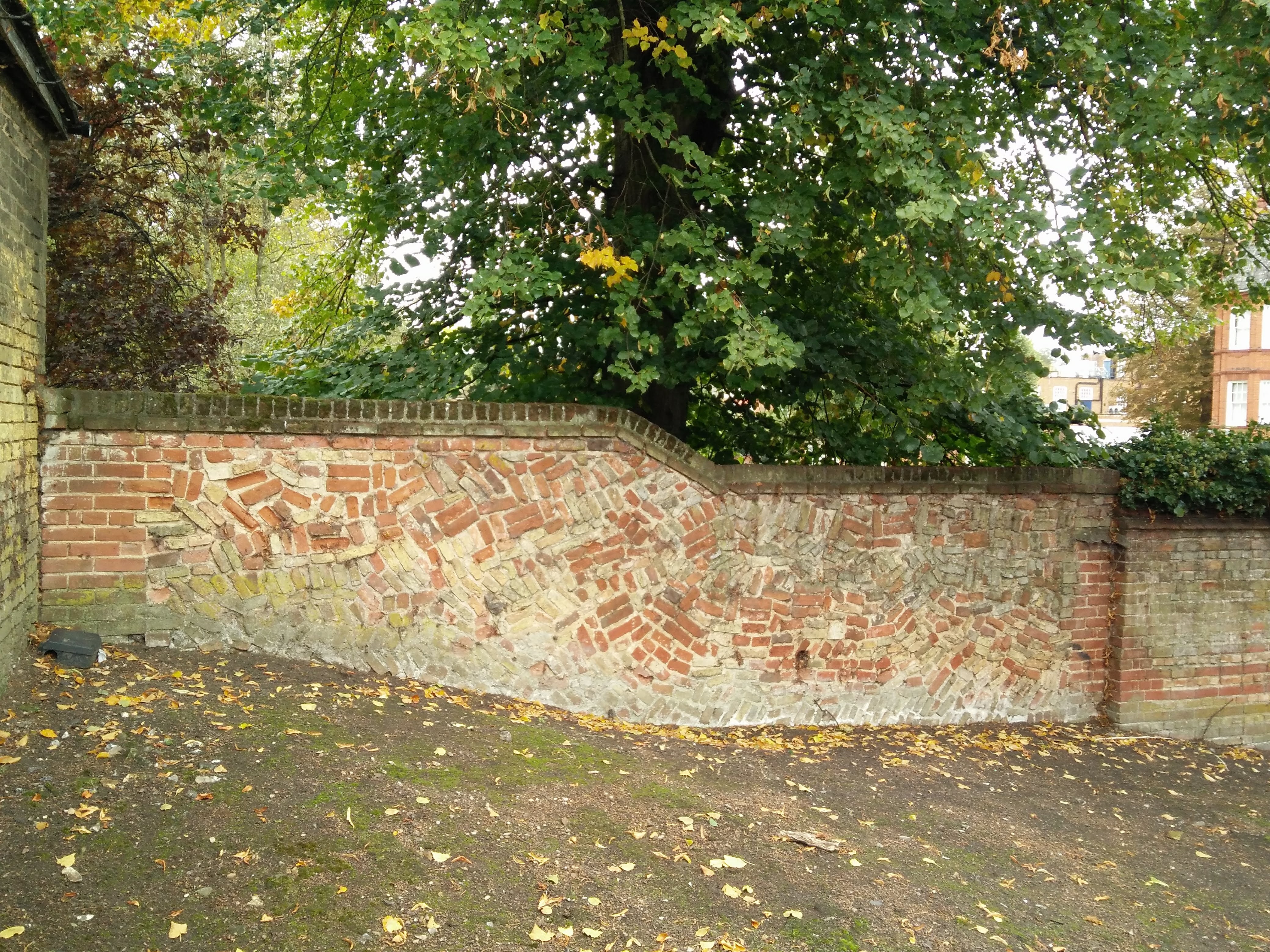
1902-June 1904 Mr Harry Marsh
After Charles Waugh moved on from Park Lodge the lease was taken over by Mr Harry Marsh, ably supported by his son, Harry Marsh junior. On Saturday 10th January 1903 Harry Marsh junior left the stables bound for Lambourn to take up the Assistant Trainer's post under Mr Howard Jones.
1904-March 1906 Mr Charles D Marnes
In June 1904 Mr Charles David Marnes, formerly a trainer in Winchester, took up training duties at Park Lodge, remaining in charge until March 1906 when he moved to Hill House, East Ilsley.
March 1906-December 1907 Reginald Day
In March 1906 Reginald Day took up training duties at Park Lodge, scoring a major success with Donetta in the Great Jubilee Handicap at Kempton Park. By December 1907 he was enticed to Germany to train for the Kaiser at the Royal Graditz Stud. Gradually, as War became inevitable, Reg returned to England in 1912, continuing his training career at Terrace House. He had first trained privately for Sir Edgar Vincent at Lowther House on St Leger Day in 1900 aged 17, and was still riding out at 80. Lowther House (30 boxes) was put up for let in autumn 1904 but he remained there and at Terrace House until he moved to Park Lane in early 1906.
December 1907-1911 John Edward Brewer, William Clark, Lionel Robinson
After Reginald Day left Park Lodge in December 1907 Mr John Edward Brewer, a former Australian trainer, ably supported by Mr William Clark and Mr Lionel Robinson, moved from Balaton Lodge to Park Lodge. John Brewer was born in Australia in 1868, training in his native country to begin with, before moving to train at Lewes. He was an accomplished rider, winning the 1891 Caulfield Grand National Steeplechase on Busaco. He then moved from Lewes to Epsom in April 1899 and married Edith Nightingall, sister of William and Arthur Nighingall, on 16th June 1900. When he travelled over from Australia he brought The Grafter, 1898 Melbourne Cup winner, with him, landing the City and Suburban at Epsom in April 1900. He and his new wife travelled back to Australia on 22nd June 1900. Brewer returned to England in 1907 to taking up a training post at Park Lodge. In early 1911 John Brewer developed a significant swelling on his neck which required urgent surgery in Cambridge, but then he and Richard Wootton purchased Kiscatoo Station Stud, on the banks of the Lachlan river in New South Wales. He died of a heart affliction on Tuesday 14th April 1931 at Elsternwick near Melbourne.
1912-1914 Honourable Francis Lambton
Before the outbreak of the First World War the Honourable Francis Lambton, brother to the more famous racehorse trainer George Lambton, trained at Park Lodge before being tragically killed in action in France. As early as August 1912, in his time at Park Lodge, Francis was charged with the care of the horses of Mr Fairie who decided to move them from Manton.
1915-1918 John Green
John 'Jack' Green was born at Nottingham on 3 April 1878 and worked as head lad for the Hon Francis Lambton at Park Lodge, holding the licence during the Great War, training principally for Lords Sefton, Suffolk and Coventry and the Hon Charles Lambton, training his first winner in November 1914. In early 1919 Park Lodge was leased to Jack Jarvis and John Green moved to Heath House just for that year.
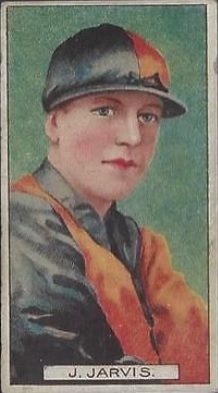
1919-1968 Sir Jack Jarvis
Probably the most successful and best known trainers to train at Park Lodge was Sir Jack Jarvis, with Blue Peter (SR 2089) owned by the 6th Earl of Rosebery and ridden by Eph Smith, winner of the 1939 2000 Guineas and Epsom Derby, his best horse. However, he was denied the Triple Crown because the St Leger was cancelled due to the outbreak of the Second World War. Sir Jack Jarvis, born John Layton Jarvis on 27th December 1887 at Waterwitch House in Newmarket, into a racing family, the third son of William Arthur Jarvis. He became an apprentice at his father's stables in 1902 and rode his first winner when he was just 14 years of age. He was a successful jockey, winning the 1902 Cambridgeshire on Hackler's Pride, followed by the 1905 Ayr Gold Cup on Kilglass. However, his weight denied him the chance of continuing as a Flat jockey and he transferred to National Hunt racing, but retired in his early 20s to work as assistant trainer to his father for the next 5 years. When the First World War broke out in 1914 Jack, aged 27, took over as private trainer to Mr A E Barton at Warren House stables, although the yard had to close in 1916 when Jack served in the Tank Corps. He took charge at Park Lodge after returning from the First World War, continuing to train there until his death in 1967. At the start of his training career Jack Jarvis was supported by the 5th Earl of Rosebery who sent 18 horses to be trained at Park Lodge, remaining loyal to Jack until the Earl died in 1929. However, his son the 6th Earl of Rosebery remained with Jack after his father's death.
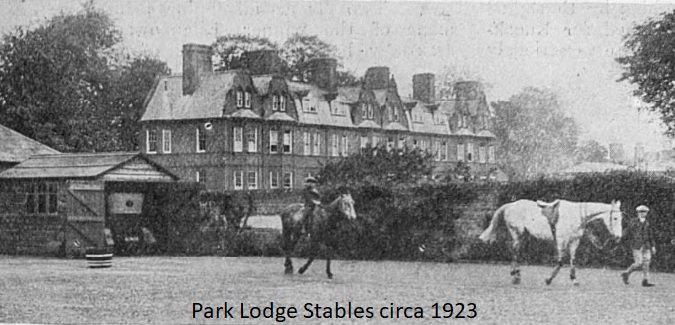
Jack Jarvis was known for training his horses hard, which led to early success in the 1922 Ascot Gold Cup with Sir George Bullough's Golden Myth. Classic success quickly followed when in 1923 Ellangowan (SR 1985) landed the 2000 Guineas, although the horse ran down the field in Papyrus's (SR 1985) Epsom Derby. This success attracted attention and acted as a catalyst in bringing prominent and wealthy owners to Park Lodge. Not least the 5th, and later 6th, Earl of Rosebery, the first enjoying Classic successes in 1923 with Ellangowan (SR 1985), followed the next year with Plack (SR 1905) in the 1000 Guineas. The 6th Earl of Rosebery captured the 1931 St Leger with Sandwich (SR 1913), but achieved even greater success with two Epsom Derby victories, initially in 1939 with Blue Peter (SR 2089), and again in 1944 with Ocean Swell (SR 2033). In 1939 he won his first British Flat Trainers Championship.
BLUE PETER
The bay colt Blue Peter (SR 2089), by Fairway out of Fancy Free, was born in 1936 and bred by the Mentmore Stud. He was owned by Harry Primrose, the 6th Earl of Rosebery and trained at Park Lodge by Jack Jarvis. He raced twice as a two-year-old, being unplaced in his inaugural race and following it with a promising second behind Foxbrough in the 1938 Middle Park Stakes. However, it was as a three year old that he showed his true ability, remaining undefeated throughout the season. He won the Blue Riband Trial Stakes before winning his first Classic, the 2000 Guineas, beating Heliopolis by an impressive 4 lengths. He then won the Epsom Derby and the Eclipse Stakes at Sandown, but was denied the chance to win the Triple Crown when the St Leger was cancelled due to the outbreak of the Second World War. He had a successful stud career, being named leading broodmare sire in Great Britain and Ireland in 1954. He died three years later aged 21 and was buried in the grounds of Mentmore Stud.
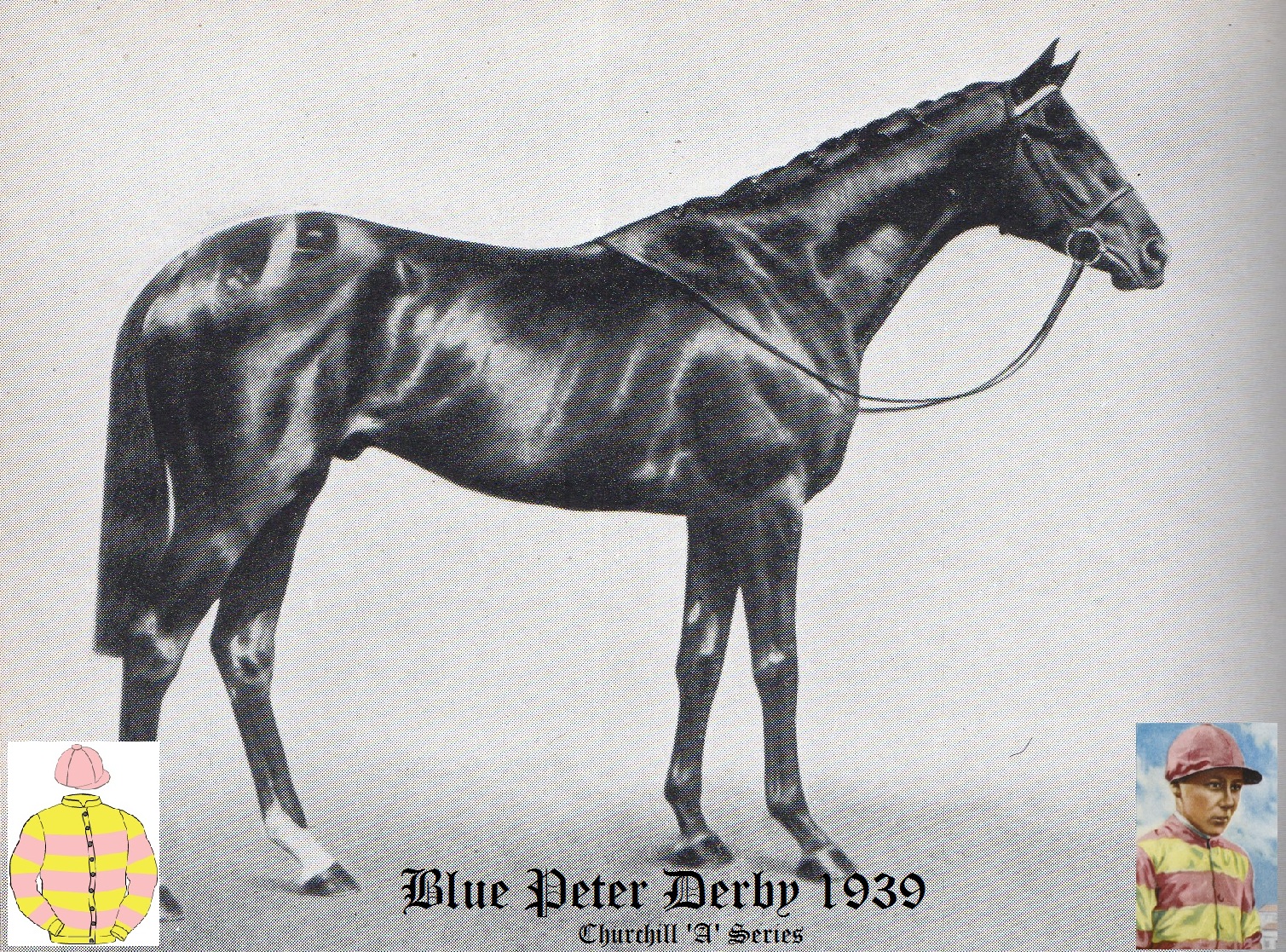

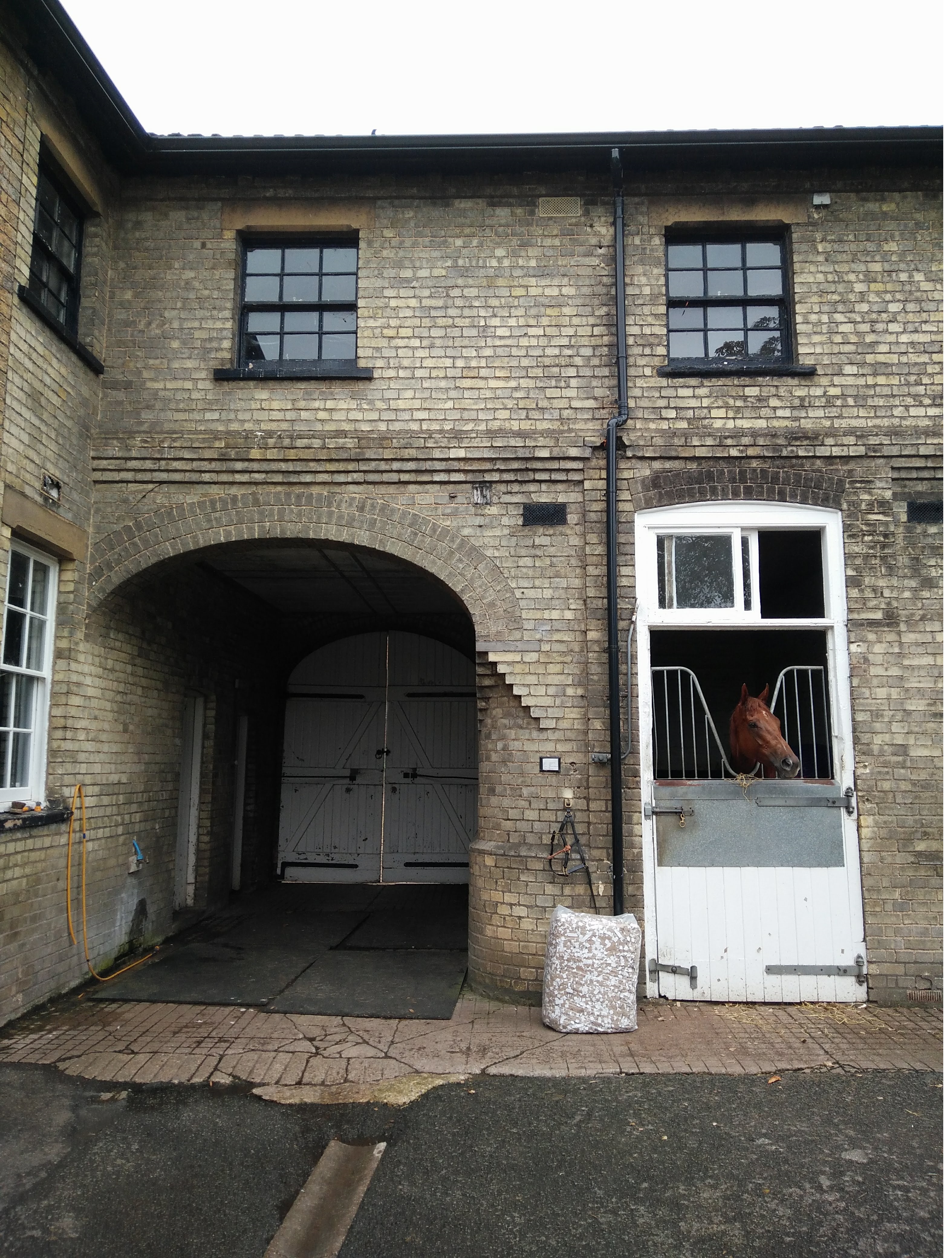
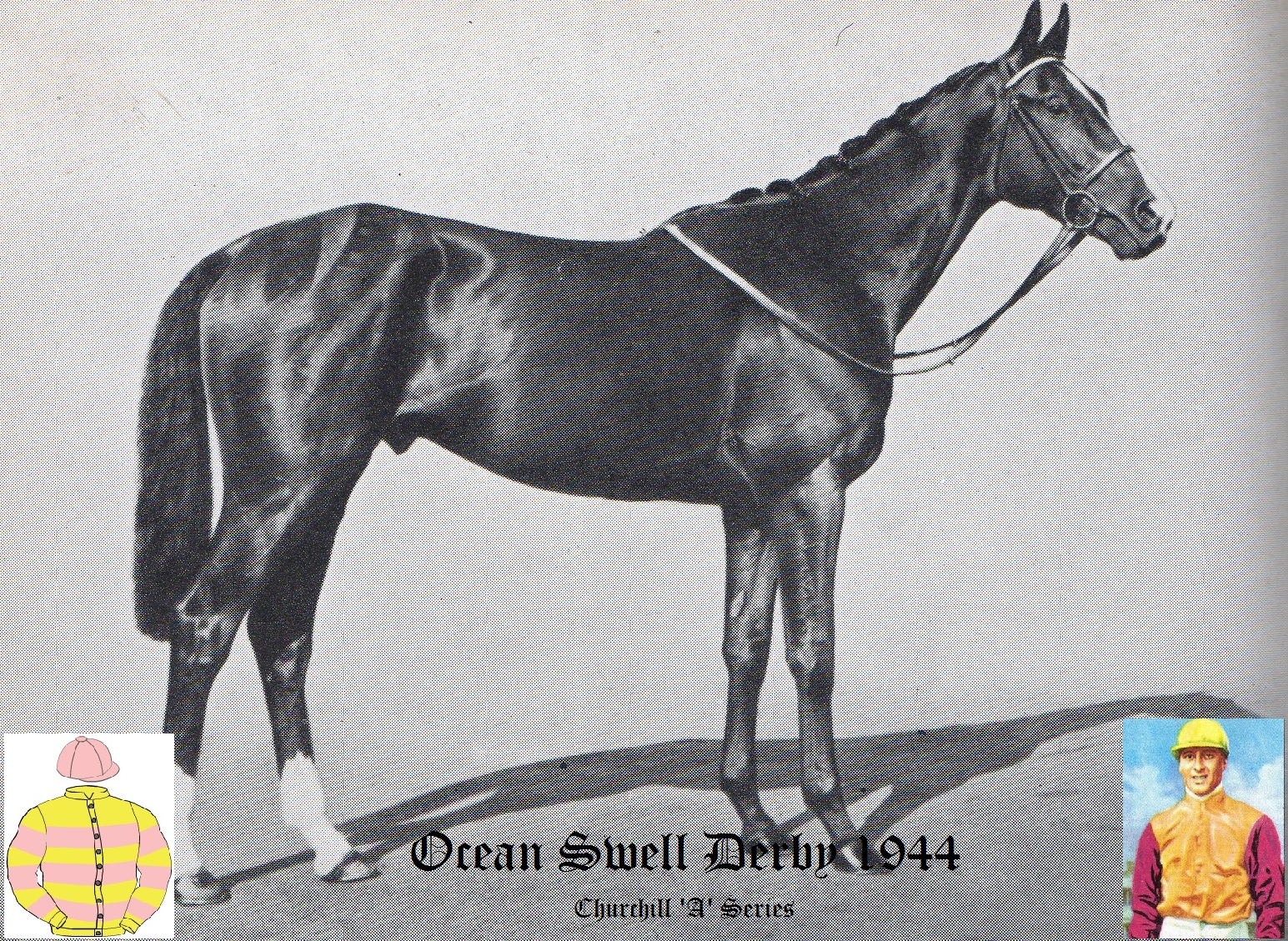
OCEAN SWELL
The bay colt, with white socks on both hind legs, Ocean Swell (SR 2033), by Blue Peter out of Jiffy, was born in 1941 and was bred by his owner 6th Earl of Rosebery. In a career spanning 15 races he won on 6 occasions. He was unplaced in all three of his two-year-old races, but during his 3-year-old career he won the Wartime New Derby, beating Tehran and Happy Landing by a neck and short head respectively, although that form was over-turned in the St Leger where he finished behind Tehran and Borealis. As a 4-year-old he developed into a promising stayer, winning the Jockey Club Stakes and, the next year, the Gold Cup. His stud career was not promising and he was put down in 1954 because of a leg injury.
In 1948 Bill Rickaby was asked to be stable jockey, taking up his post at the start of the 1949 season. There was a family link, because Bill married Sir Jack Jarvis's niece Bridget, and he continued to ride as stable jockey for the next 7 years. In 1950, such was Sir Jack's success, he opened a second training yard at nearby Palace House, promptly winning back to back British Flat Trainers Championships in 1951 and 1952. His final Classic victory was in 1953 when the filly Happy Laughter (SR 1907), owned by Mr David Wills and ridden by the ill-fated Manny Mercer, won the 1000 Guineas. In 1965, when aged 77, reduced his training commitments by releasing his lease on Palace House, and two years later he was knighted by the Queen. Sir Jack died on 18th December 1968. In his will, announced in January 1969, Sir Jack left £211,618 (equivalent today to £3.4 million). At the time of his death he had a 2-year-old Sleeping Partner in his Park Lodge stable, and on the evening before he died he is said to have prophesised that Sleeping Partner would win the Oaks. A year later that prophecy came true when the filly went on to capture the Epsom Oaks (SR 1877) for the 6th Earl of Rosebery when trained by Doug Smith, a success which was even more poignant because it was the one Classic which had eluded Sir Jack.
1922 Ascot Gold Cup GOLDEN MYTH owned by Sir George Bullough, trained by Sir Jack Jarvis and ridden by Charlie Elliott
1923 2000 Guineas ELLANGOWAN (SR 1985) owned by the 5th Earl of Rosebery, trained by Sir Jack Jarvis and ridden by Charlie Elliott
1924 1000 Guineas PLACK (SR 1905) owned by the 5th Earl of Rosebery, trained by Sir Jack Jarvis and ridden by Charlie Elliott
1928 2000 Guineas FLAMINGO (SR 1969) owned by Sir Laurence Philipps, trained by Sir Jack Jarvis and ridden by Charlie Elliott
1931 Doncaster St Leger SANDWICH (SR 1913) owned by the 6th Earl of Rosebery, trained by Sir Jack Jarvis and ridden by Harry Wragg
1933 Ascot Gold Cup FOXHUNTER owned by Edward Esmond, trained by Sir Jack Jarvis and ridden by Harry Wragg
1934 1000 Guineas CAMPANULA (SR 1986) owned by Sir George Bullough, trained by Sir Jack Jarvis and ridden by Harry Wragg
1939 2000 Guineas BLUE PETER (SR 2089) owned by 6th Earl Rosebery, trained by Sir Jack Jarvis and ridden by Eph Smith
1939 Epsom Derby BLUE PETER (SR 2089) owned by 6th Earl Rosebery, trained by Sir Jack Jarvis and ridden by Eph Smith
1939 Ascot Gold Cup FLYON owned by 1st Baron Milford, trained by Sir Jack Jarvis and ridden by Eph Smith
1944 Epsom Derby OCEAN SWELL (SR 2033) owned by the 6th Earl of Rosebery, trained by Sir Jack Jarvis and ridden by Billy Nevett
1949 Yorkshire Oaks UNKNOWN QUANTITY
1950 Champion Stakes PETER FLOWER
1953 Chester Cup EASTERN EMPEROR trained by Sir Jack Jarvis and ridden by Bill Rickaby
1953 1000 Guineas HAPPY LAUGHTER (SR 1907) owned by Mr David Wills, trained by Sir Jack Jarvis and ridden by Manny Mercer
1955 Chester Cup PRESCRIPTION trained by Sir Jack Jarvis and ridden by Bill Rickaby
At the 1946 Royal Ascot meeting Newmarket Stables won a greater proportion of first prize money than any other location, outperforming France, Middleham and other prominent racing centres. Seven different Newmarket Stables provided winners, with Jack Jarvis leading the way.
Jack Jarvis
Ascot Stakes:-REYNARD VOLANT (8/1)
Cork & Orrery Stakes (Diamond Jubilee Stakes):-HONEYWAY (5/6 fav)
Queen Anne Stakes:-ROYAL CHARGER (5/6 fav)
Frank Butters
King Edward VII Stakes:-FIELD DAY (5/2 fav)
New Stakes (Norfolk Stakes):-PETITION (7/4 jt fav)
St James's Palace Stakes:-KHALED (2/1)
T E Leader
Royal Hunt Cup:-FRIAR'S FANCY (15/2)
Reg Day
King George V Stakes:-AURALIA (9/1)
Lawson
King's Stand Stakes:-VILMORIN (10/1)
Fred Armstrong
Britannia Stakes:-FRENCH TOY (100/9)
Cecil Boyd-Rochfort
Gold Vase (Queen's Vase):-LOOK AHEAD (20/1)

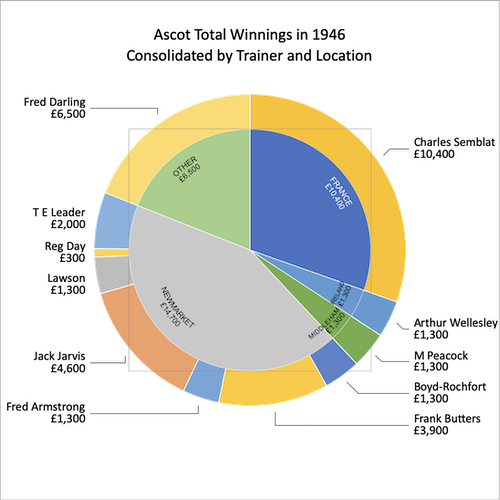
1965-1978 Park Lodge Nursery/Maiden Stakes over 6 furlongs
In the mid-1960s six of the most prestigious, historic racing stables in Newmarket were honoured by having races named after them on the July course on the Saturday of the late August meeting. One of the six selected was Park Lodge Stables, which continued into the 1980s despite the Philip Cornes sponsored events replacing some of the other Stable's races, and was the final one of the 6 stables to be replaced, with results shown below:-
1965 Park Lodge Stakes was won by OUT OF ORBIT (4/1) ridden by Brian Taylor
1966 Park Lodge Stakes was won by SHARP WORK (9/4) trained by J Dennistoun and ridden by Lester Piggott
1967 Park Lodge Stakes was won by WIND AND WATER (6/1) trained by Jack Jarvis and ridden by Paul Cook
1968 Park Lodge Stakes was won by SILVER SPRAY (4/1) trained by Sir Jack Jarvis and ridden by Bill Rickaby
1969 Park Lodge Stakes was won by SOOTHING (8/1) trained by John Waugh and ridden by Paul Tulk
1970 Park Lodge Stakes was won by SEVENTH BRAVE (20/1) trained by P Bailey and ridden by Brian Jago
1971 Park Lodge Stakes was won by JEUNE PREMIER (33/1) trained by Bill Payne and ridden by Michael Ketle
1972 Park Lodge Stakes was won by PRITILLOR (33/1) trained by John Winter and ridden by David Maitland
1973 Park Lodge Stakes was won by MAJOR DILKE (3/1) trained by Alan Jarvis and ridden by Frankie Durr
1974 Park Lodge Stakes was won by FASTACRE (5/1) trained by Scobie Breasley and ridden by Frankie Durr
1975 Park Lodge Stakes was won by MARKET SAGE (6/1) trained by Hugh Collingridge and ridden by Graham Sexton
1976 Park Lodge Stakes was won by MECANOPSIS (10/1) trained by Bruce Hobbs and ridden by Geoff Baxter
1977 Park Lodge Stakes was won by GLINTING (6/4 fav) trained by Michael Stoute and ridden by Edward Hide
1978 Park Lodge Stakes was won by CREWS HILL (100/30 jt fav) trained by Clive Brittain and ridden by Edward Hide
1969-1975 Doug Smith
At the start of the 1969 season, after the death of Sir Jack Jarvis on 18th December, Doug Smith, former champion jockey, took over the reins at Park Lodge, with Michael Stoute as his assistant and Bill Rickaby returning for a second stint as stable jockey. Doug continued to operate at his other place, Loder Stable, leaving Michael Stoute running day to day affairs at Park Lodge. Within a year the pair enjoyed a Classic success with Sleeping Partner in the Epsom Oaks, so Michael would have some claim to this being his first Classic winner.
1969 Epsom Oaks SLEEPING PARTNER (SR 1877) owned by 6th Earl of Rosebery, trained by Doug Smith and ridden by John Gorton
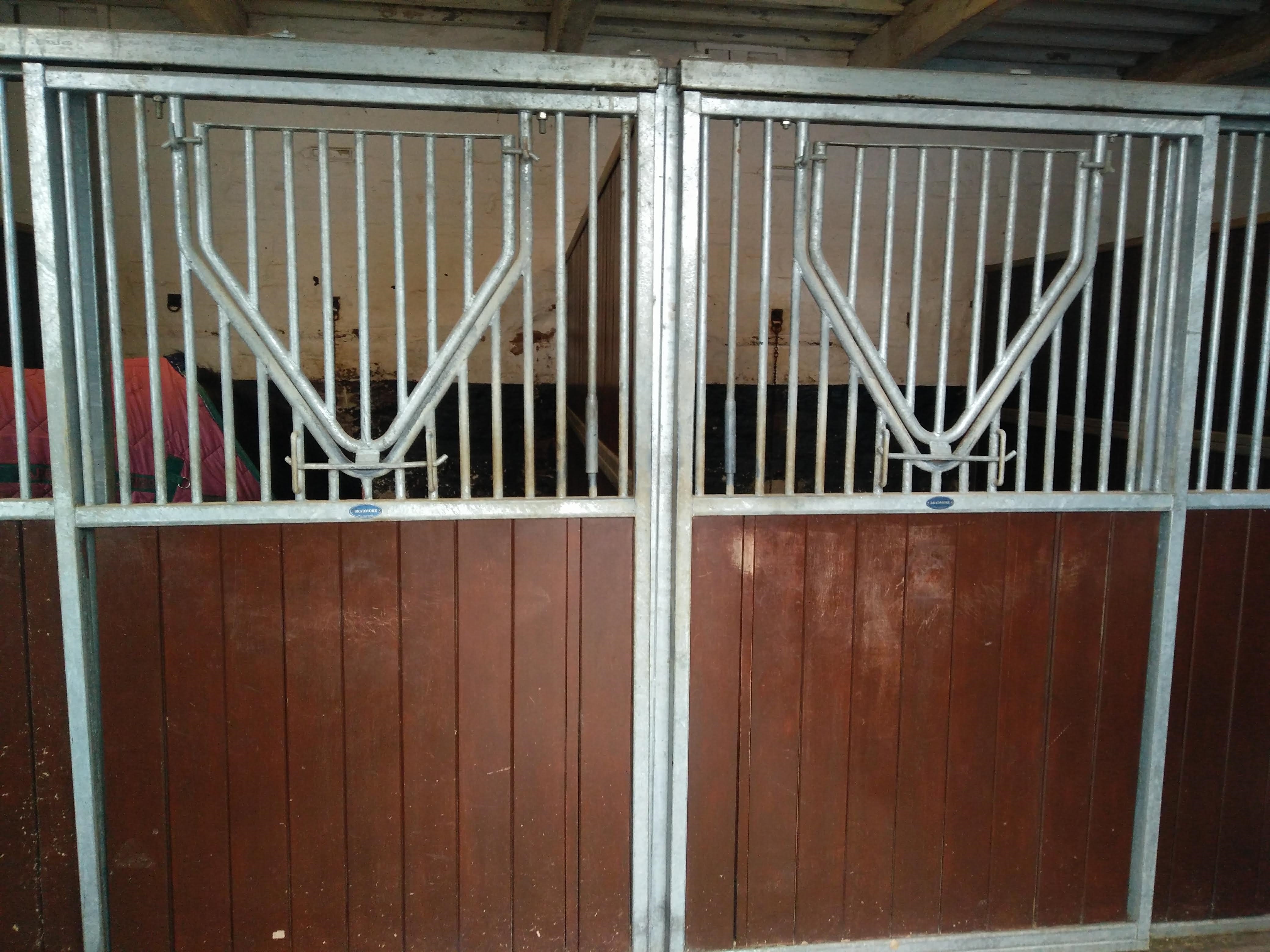
The grey mare Sleeping Partner (SR 1877) by Parthia out of Old Dutch, foaled in 1966, was owned by Harry Primrose, the 6th Earl of Rosebery and was one of the last batch of yearlings handled by Sir Jack Jarvis. On the evening he died he prophesied that she would win the Epsom Oaks, the only English Classic which eluded him. Doug Smith took over from Sir Jack at Park Lodge in 1969, ably assisted by Michael Stoute, and duly won the 1969 Oaks. She raced 7 times as a two-year-old, but managed just a single win at Ayr in a maiden. However, as a three-year-old she won the Lingfield Oaks Trial, the Epsom Oaks and the Ribblesdale. She raced a total of 13 times, winning on 4 occasions, but then proved a disappointment as a brood mare.
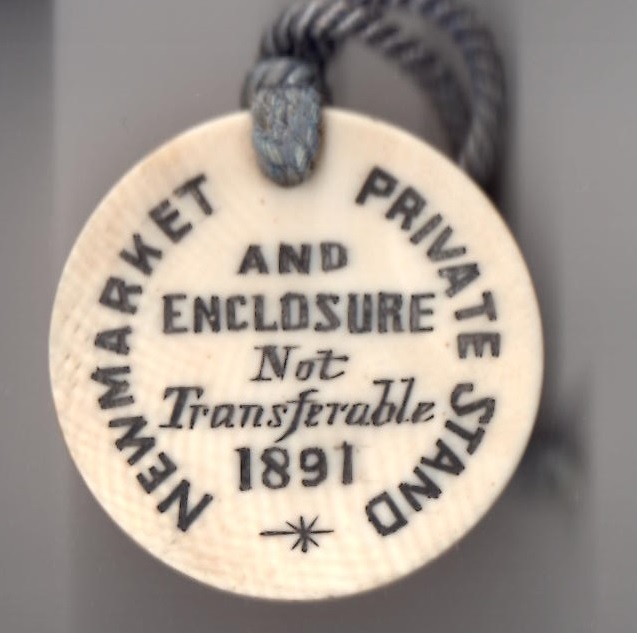
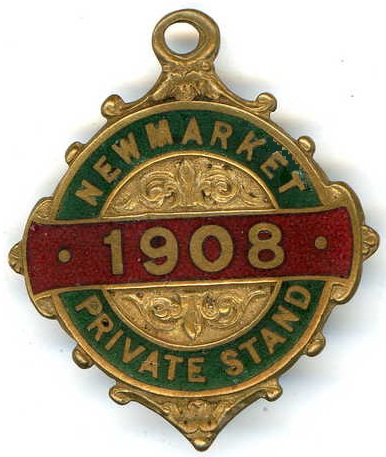
1976-1988 Ron Sheather, Richard Galpin, Jeff Smith, Ray Cochrane
When Doug Smith moved out in 1975, Richard Galpin purchased Park Lodge Stables, putting Ron Sheather in charge in 1979 after he had trained for just one year at Coronation Stables, also owned by Richard Galpin. Galpin had launched his career in racing in the latter part of the 1950s, working as a trainer and a racing journalist. He became better known as a Newmarket based bloodstock agent, well-known for spotting relatively inexpensive top-quality horses, including 1978 Epsom Oaks winner Fair Salina (SR 1928) and David Junior. Richard Galpin decided to plant 6 horse chestnut trees on the grassy area in front of the stable block, thinking that it would resemble training establishments more typically seen in France. Also, at this time, there was a giant ‘muck’heap’ in the centre of the grassed area, covering a deep, underground spring well. Galpin's time was short-lived and in 1981 he sold Park Lodge to successful businessman Jeff Smith. It was during this period that Jeff Smith and Ron Sheather bonded well, enabling Ron to enjoy his most successful period as a trainer. His best horse during his stint at Park Lodge was Chief Singer, a brown colt by Ballad Rock out of Principia who captured the Coventry Stakes as a two-year-old, and went on to win the St James's Palace Stakes, July Cup and Sussex Stakes when ridden by Ray Cochrane. Ray Cochrane had enjoyed limited success as a National Hunt jockey, but weight prevented him from reaching similar heights as a Flat jockey early in his career. That all changed due to a freak accident at Park Lodge Stables. Ray noticed that an electric bulb needed changing in one stable block and fetched a ladder to make the change himself despite a horse remaining in the box. The horse became inquisitive, and excited, knocking Ray off the ladder and breaking his leg. Ray was taken to hospital as a 10 stone jump jockey, emerging some months later as an 8 1/2 stone jockey with the potential to become a fully-fledged Flat race jockey, steering Chief Singer to his many Group 1 victories. Towards the very end of Ron Sheather's time at Park Lodge training duties were shared with Rae Guest, but this ended in 1988. Park Lodge Stables were left empty for over 12 months, becoming tired, run-down and in need of some tender loving care.
1981 Lincoln Handicap SAHER (14/1) owned by Jeff Smith, trained by Ron Sheather and ridden by Ray Cochrane
1983 Coventry Stakes, Ascot CHIEF SINGER, owned by Jeff Smith, trained by Ron Sheather and ridden by Ray Cochrane
1984 St James’s Palace Stakes, Ascot CHIEF SINGER, owned by Jeff Smith, trained by Ron Sheather and ridden by Ray Cochrane
1984 July Cup, Newmarket CHIEF SINGER, owned by Jeff Smith, trained by Ron Sheather and ridden by Ray Cochrane
1984 Sussex Stakes, Goodwood CHIEF SINGER, owned by Jeff Smith, trained by Ron Sheather and ridden by Ray Cochrane

1989-February 2021 James Eustace
James Eustace, and his wife Gay, provided the tender loving care needed to return Park Lodge Stables to its former glory days, succeeding Ron Sheather in April 1989, with Penny Mint marking his arrival with early successes. Philidor arrived at Park Lodge in 1990 and went on to win many times at Goodwood, recording three career successes at the Sussex track. He won three times over the glorious Sussex track, the highlight being his short-head success in the 1993 Schweppes Golden Mile. Major victories followed with Refuse to Lose, Rapscallion, Orcadian and War Artist.
James was born into a family which loved horses, learning to ride at an early age, he embraced all forms of equestrian sport, including hunting, show-jumping, point-to-point racing and eventing. He was at school with another Newmarket trainer, William Jarvis, later working for him for 4 years prior to taking out his owner trainer's licence. He arrived in Newmarket in 1979, taking a job at Flint Cottage Stables which were then run by Mark Tompkins. To broaden his experience, he crossed the Atlantic in 1983 to work for trainer John Sullivan in California, returning in 1985 to work for William Jarvis. In 1989 he noticed that Park Lodge Stables was on the market, and although he was torn between purchasing the historic stables or opting for one of the new stables being leased by the Jockey Club on the Hamilton Road, he chose correctly and has never looked back.
Gay was born into a racing family, her father was a racehorse trainer, while his father, F B Rees, was a Grand National winning jockey. Frederick Brychan Rees, known universally as Dick, was the son of a Pembrokeshire vet, and enjoyed hunting and point-to point racing. Prior to the outbreak of the First World War he rode for a Tenby trainer, Mr Harrison, but during the War he was in the Sussex Yeomanry. Once the War was over, he became an amateur rider before turning professional in 1920, and such was his success that he was crowned champion National Hunt jockey on 5 occasions. However, the highlight of his career came in 1921 when he won the Grand National on Shaun Spedah (100/9) for Mr T McAlpine. His brother, Gay's great uncle, Lewis Bilbie (L B) Rees won the Grand National the next year on Music Hall (100/9) for Mr Hugh Kershaw.
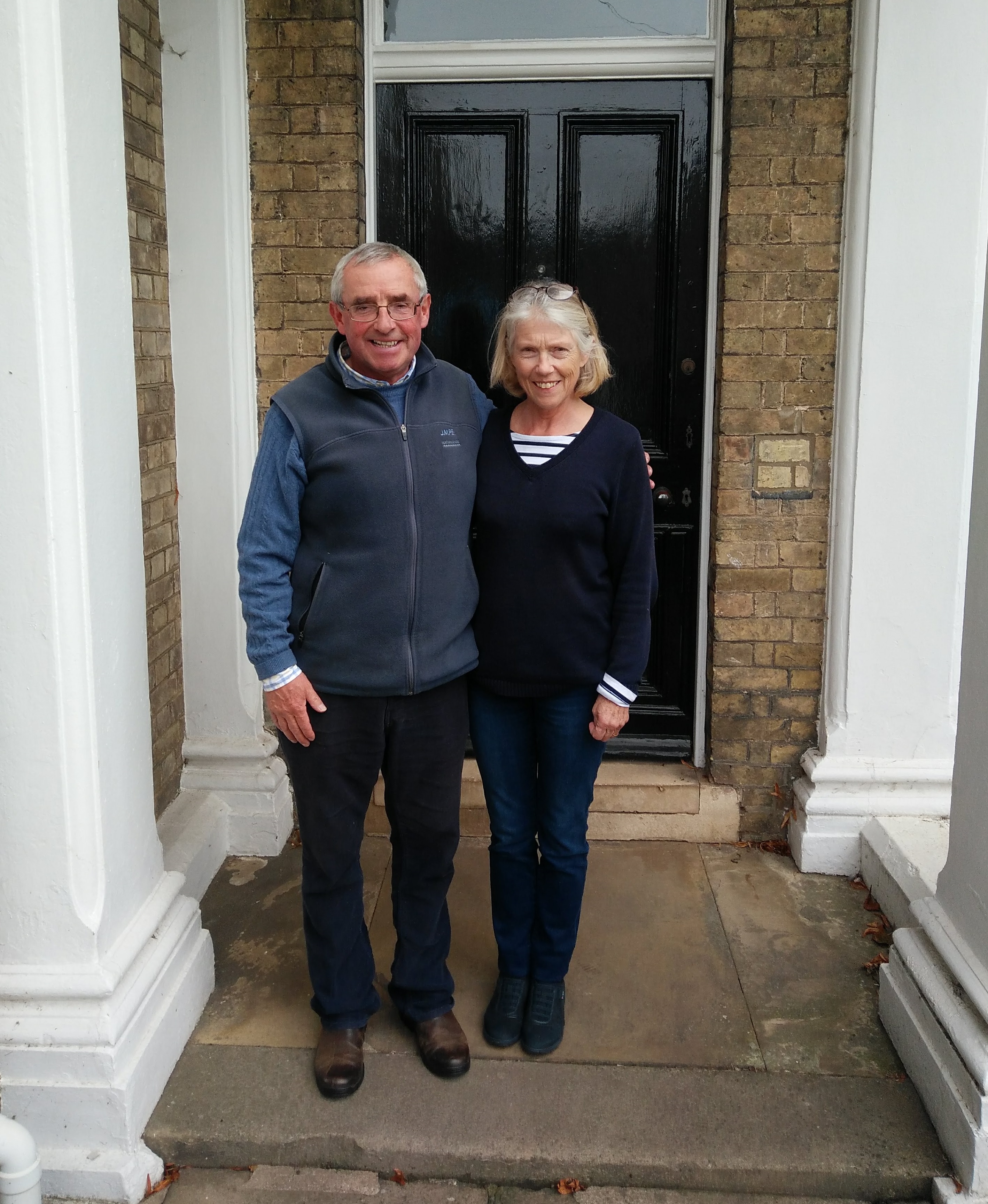
1998 Royal Hunt Cup at Ascot REFUSE TO LOSE (20/1) owned by Jeff Smith, trained by James Eustace and ridden by James Tate
2001 Horris Hill Stakes at Newbury RAPSCALLION (7/2) owned by Jeff Smith, trained by James Eustace and ridden by James Tate
2001 Newcastle Bladon Nursery Handicap SALUTE (11/1) owned by Blue Peter Racing, trained by James Eustace and ridden by James Tate
2004 St Simon Stakes at Newbury ORCADIAN (33/1) owned by Jeff Smith, trained by James Eustace and ridden by Martin Dwyer
2005 Newbury Steventon Listed Stakes WELCOME STRANGER (14/1) owned by H R Moszkowicz, trained by James Eustace and ridden by Luke Fletcher
2009 Longchamp Prix de Petit Couvert (Group 3) WAR ARTIST (2/1) owned by Vintage Thoroughbreds, trained by James Eustace and ridden by Olivier Peslier
2009 Baden Baden Goldene Peitsche (Group 2) WAR ARTIST (3/1) owned by Vintage Thoroughbreds, trained by James Eustace and ridden by Andreas Suborics
2010 Meydan Al Shindagha Sprint (Group 3) WAR ARTIST (7/2) owned by Vintage Thoroughbreds, trained by James Eustace and ridden by Olivier Peslier
March 2021-present Harry Eustace
Having spent over 30 years training at Park Lodge Stables James Eustace retire from the training ranks in early 2021, allowing son Harry to take charge at the historic stables. Harry ventured to Australia to gain experience with Lee Freedman and Peter Snowden before working for the Irish National Stud. He gained further training experience working as assistant trainer to Chris Wall, and then spent 2 years with Jeremy Noseda before taking charge of his first barn in the USA for Christophe Clement. On his return to England he worked in Newmarket as assistant to William Haggas for 4 years before he, and his father, thought the time was right to take over the reins of Park Lodge.
BLUE PETER (1939 Epsom Derby, 2000 Guineas)
THE BARD (1886 Goodwood Cup, Doncaster Cup, 16 consecutive 2-y-o wins in 1885)
OCEAN SWELL (1944 Irish Derby)
ELLANGOWAN (1923 2000 Guineas)
SANDWICH (1931 St Leger)



